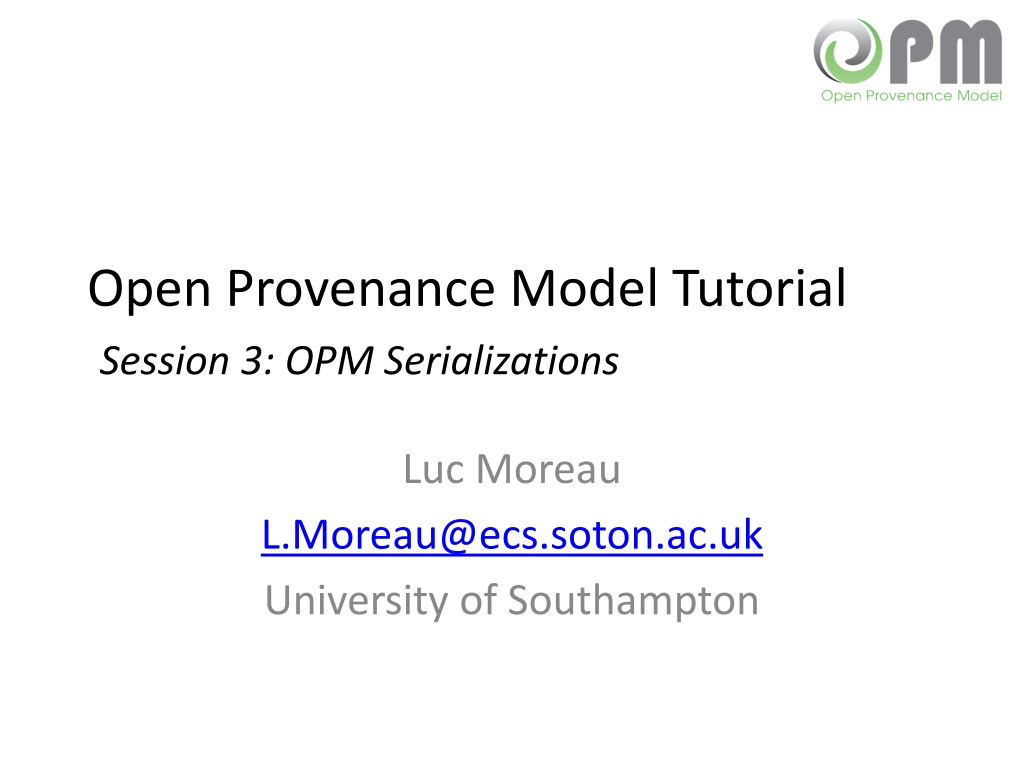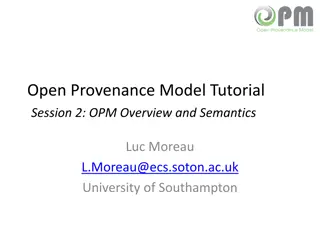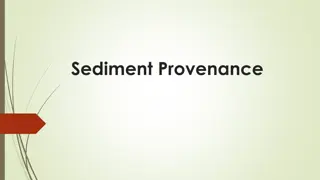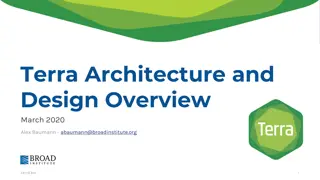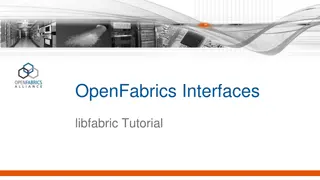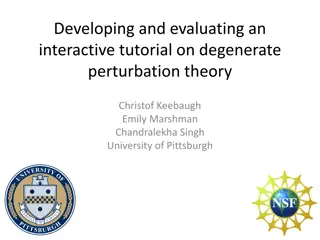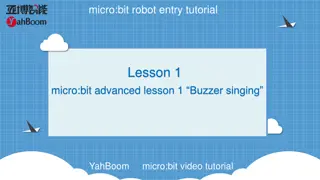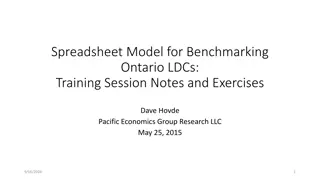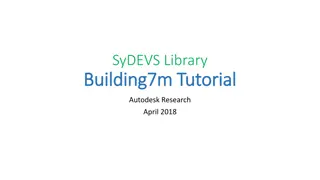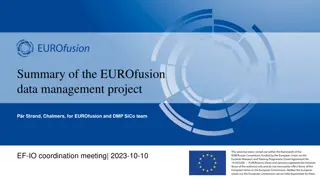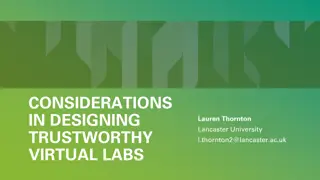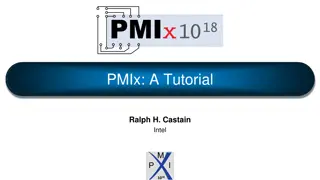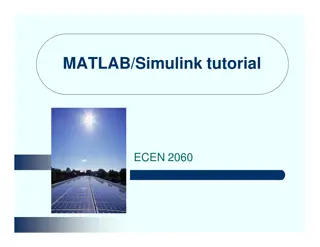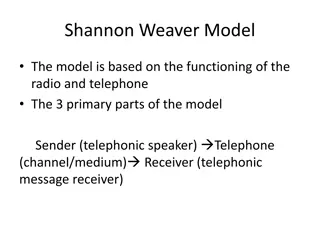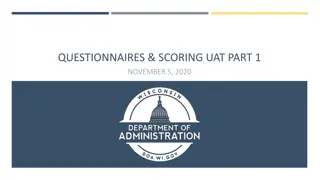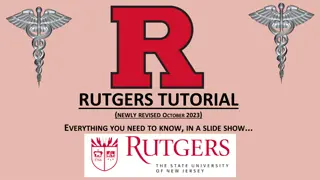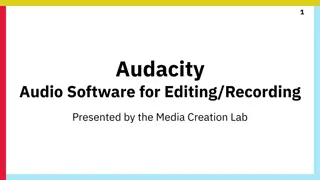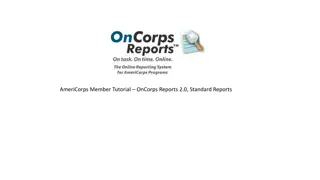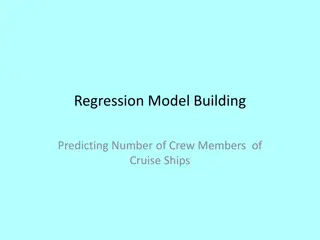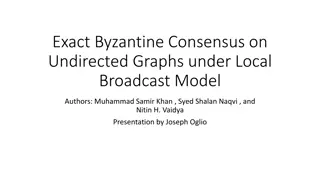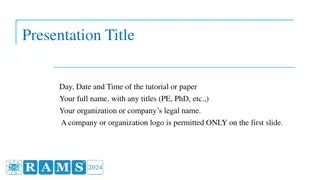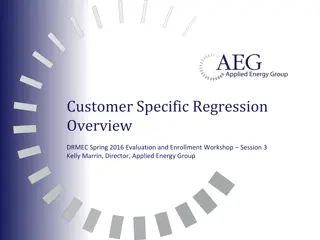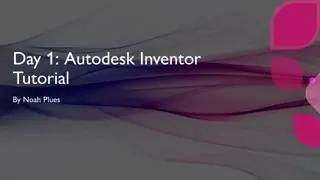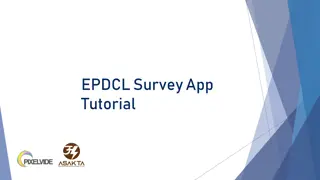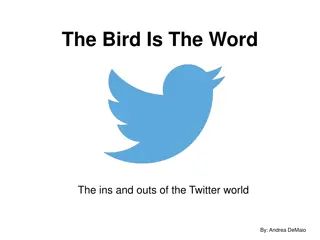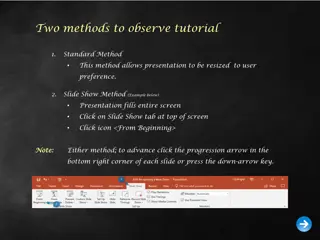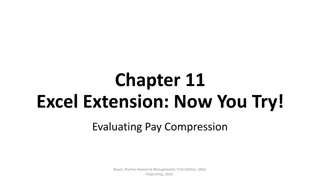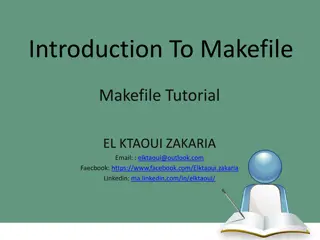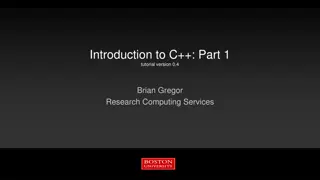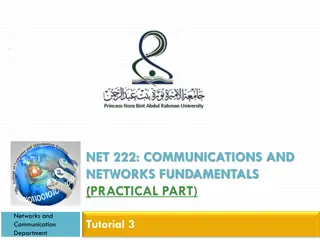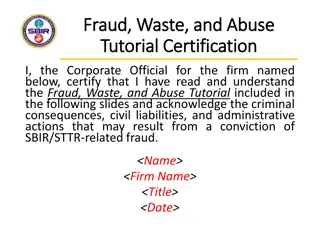Overview of Open Provenance Model Tutorial Session 3
Explore Session 3 of the Open Provenance Model Tutorial, covering topics like the XML Schema for OPM, OWL ontology, OPM Layered Architecture, XML Binding, RDF Binding, and more. Dive into OPM Layered Model, XML Binding, OPM Graph, OPM Process, and OPM Artifact to understand specialized domains and essential profiles within the OPM Core.
Download Presentation

Please find below an Image/Link to download the presentation.
The content on the website is provided AS IS for your information and personal use only. It may not be sold, licensed, or shared on other websites without obtaining consent from the author. Download presentation by click this link. If you encounter any issues during the download, it is possible that the publisher has removed the file from their server.
E N D
Presentation Transcript
Open Provenance Model Tutorial Session 3: OPM Serializations Luc Moreau L.Moreau@ecs.soton.ac.uk University of Southampton
Session 3: Aims In this session, you will learn about: The XML Schema for OPM The OWL ontology for OPM
Session 3: Contents OPM Layered Architecture XML Binding RDF Binding RDF Binding with OWL Inferences Conclusion
OPM Layered Model OPM Domain Specialization: Workflow, Web Technology Bindings: XML, RDF OPM based APIs: record, query OPM Essential Profiles: Collections, Attribution OPM Core OPM Sig 5
OPM Graph <opm:opmGraph xmlns:opm="http://openprovenance.org/model/v1.1.a" xmlns:xsi="http://www.w3.org/2001/XMLSchema-instance" xmlns:xsd="http://www.w3.org/2001/XMLSchema" xmlns="http://example.com/"> <opm:accounts/> <opm:processes> <opm:artifacts/> <opm:agents/> <opm:causalDependencies/> </opm:opmGraph>
OPM Process <opm:process id="p1"> <opm:account ref="black"/> <opm:label value="align_warp 1"/> <opm:annotation id="an1_p1"> <opm:property uri="http://openprovenance.org/primitives#primitive"> <opm:value xsi:type="xsd:string"> http://openprovenance.org/primitives#align_warp </opm:value> </opm:property> </opm:annotation> </opm:process> id: xs:ID implies uniqueness within document account membership label: for pretty printing annotation: set of property key value pairs
OPM Artifact <opm:artifact id="a1"> <opm:account ref="black"/> <opm:label value="Reference Image"/> <opm:type value="http://openprovenance.org/primitives#File"/> <opm:annotation id="an1_a1"> <opm:property uri="http://openprovenance.org/primitives#path"> <opm:value xsi:type="xsd:string"> /shomewhere/pc1/reference.img </opm:value> </opm:property> </opm:annotation> </opm:artifact> id: xs:ID implies uniqueness within document account membership label: for pretty printing annotation: set of property key value pairs opm:type: a predefined OPM annotation, with compact syntax
OPM edges <opm:used> <opm:effect ref="p1"/> <opm:role value="img"/> <opm:cause ref="a3"/> <opm:account ref="black"/> </opm:used> ref: refers to nodes ids <opm:wasGeneratedBy> <opm:effect ref="a30"/> <opm:role value="out"/> <opm:cause ref="p15"/> <opm:account ref="black"/> </opm:wasGeneratedBy> <opm:wasDerivedFrom> <opm:effect ref="a11"/> <opm:cause ref="a1"/> <opm:account ref="black"/> </opm:wasDerivedFrom>
History of RDF bindings Tupelo (Futrelle) OWL ontology from Tupelo OWL ontology from Paulson OWL ontology in OPM Toolbox OWL ontology by Tetherless Team (PC3)
OWL Ontology for OPM (1) OPM toolbox allows for conversion from XML to RDF and back Ontology design principle: XML toplevel element corresponds to a OWL class Introduce an OPMGraph class Make graph membership explicit by means of properties
OWL Ontology for OPM (1) // Class: http://openprovenance.org/ontology#Used SubClassOf(Used ObjectSomeValuesFrom(cause Artifact)) SubClassOf(Used ObjectAllValuesFrom(cause Artifact)) SubClassOf(Used ObjectSomeValuesFrom(role Role)) SubClassOf(Used ObjectAllValuesFrom(role Role)) SubClassOf(Used ObjectSomeValuesFrom(effect Process)) SubClassOf(Used ObjectAllValuesFrom(effect Process)) SubClassOf(Used Edge) DisjointClasses(Used WasTriggeredBy) DisjointClasses(Used WasControlledBy) DisjointClasses(Used WasDerivedFrom) DisjointClasses(Used WasGeneratedBy)
OWL Ontology for OPM (1) pc1:p5 a opm:Process ; opm:account pc1:black ; opm:label "Reslice 1" . pc1:an1_p5 a opm:Annotation . pc1:pr_18 a opm:Property ; opm:uri "http://openprovenance.org/primitives#primitive" ; opm:value "http://openprovenance.org/primitives#reslice" . pc1:an1_p5 opm:property pc1:pr_18 . pc1:p5 opm:annotation pc1:an1_p5 . pc1:u_103 a opm:Used ; opm:effect pc1:p1 ; opm:role pc1:r_102 ; opm:cause pc1:a3 ; opm:account pc1:black . pc1:gr_273 a opm:OPMGraph ; opm:hasAccount pc1:black ; opm:hasProcess pc1:p5 , ...; opm:hasArtifact pc1:a25p, ...; opm:hasDependency pc1:u_103, ...
OWL Ontology for OPM (1) Limitations OPM edges are reified, i.e. represented as classes and not properties Transitive closure of OPM edges cannot be expressed Annotations are reified too Not natural RDF representation See http://www.jenitennison.com/blog/node/142 for a discussion But fully compatible with XML!
RDF BINDING AND OWL INFERENCES
OWL Ontology for OPM (2) Define properties to represent OPM edges Use OWL property chains to infer these edges
OWL Ontology for OPM (2) // Class: http://openprovenance.org/ontology#Used SubClassOf(Used ObjectSomeValuesFrom(causeUsed Artifact)) SubClassOf(Used ObjectSomeValuesFrom(role Role)) SubClassOf(Used ObjectSomeValuesFrom(effectUsed Process)) SubClassOf(Used Edge) // Object property: http://openprovenance.org/ontology#_used SubObjectPropertyOf(_used _used_star) ObjectPropertyDomain(_used Process) ObjectPropertyRange(_used Artifact) SubObjectPropertyOf(SubObjectPropertyChain(effectUsed-1 causeUsed) _used) // Object property: http://openprovenance.org/ontology#_used_star ObjectPropertyDomain(_used_star Process) ObjectPropertyRange(_used_star Artifact) SubObjectPropertyOf(SubObjectPropertyChain(_used _wasDerivedFrom_star) _used_star)
OWL Ontology (2) OPM inferences could alternatively be encoded as SWRL rules Problematic in the presence of multiple accounts: it is meaningless to make inference over properties corresponding to edges belonging to multiple accounts A solution is to use named graphs to represent accounts What is the semantics of OWL+SWRL+Named Graphs+SPARQL? What is the complexity?
Conclusion on OPM Bindings Two compatible bindings for RDF and XML, with lossless conversions (up to node naming) Converter makes extra-assumptions on identifiers (xs:ID in XML schema and URI in RDF) Scope of an OPM graph is not clear in RDF What other binding would be useful? Challenges in implementing OPM with Semantic Web technologies Jun Zhao s OPMV is an emerging alternative serialization of OPM in RDF
